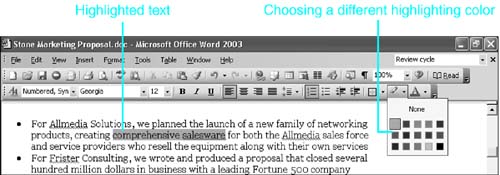An Overview of Word's Team Writing Tools
Nowadays, few documents of any size are written entirely by one individual. In the corporate setting, most documents must be shepherded through a hierarchy; increasingly they must also be reviewed by cross-functional teams. Even freelance writers, of course, face the sharp red pencils of editors?often, more than one.
Word can't do much to make the substantive aspects of the review process easier. But it can work absolute wonders for the logistics of document review. If your review needs are especially simple, Word's Highlighting tool might be enough?just as a highlighter might have been enough for you in high school. We'll cover the Highlighting tool briefly at the beginning of this chapter.
However, most of this chapter focuses on Word's industrial-strength tools for complex document reviews?features that provide a comprehensive solution for ensuring that all input and feedback are reflected as efficiently as possible. These features include
Comments, which enables reviewers to annotate your document with suggestions and recommendations without actually changing the text of the printed draft
Track Changes, which helps you track changes made by multiple reviewers and then evaluate, incorporate, or reject them one at a time?or all at once
Protect Documents, which enables you to prevent changes to your document other than comments or tracked changes
Versioning, which enables you to maintain multiple versions of a document in a single file
Close integration with Microsoft Outlook and Microsoft SharePoint to help you send file attachments to reviewers and track their progress
Using the Highlighter
Word's simplest reviewing tool is the Highlighter, which works just like the highlighting pen you might still use regularly with printed documents. For the most informal reviews, in which all you need to do is call attention to text, rather than make detailed comments about it, Word's Highlighter may be all you need.
NOTE
For any more complex reviews, Track Changes makes it far easier to track, accept, and reject specific changes made by multiple reviewers. If you want to annotate a block of text with a suggestion or question, use Word's Comments tool.
To highlight one block of text, select it and click the Highlight icon on the Formatting toolbar. By default, your text is highlighted in see-through yellow. Figure 26.1 shows highlighted text in a document.
Figure 26.1. By default, highlighted text is marked in yellow.

If you plan to highlight several blocks of text, click the Highlight button before you select any text. Then select the first block of text; Word highlights it. Select another block of text; Word highlights that one too. Word keeps highlighting text you select until you press Esc or click the Highlight button again.
If you prefer to use a color other than yellow, click the down arrow next to the Highlight button; a choice of 15 colors appears. Select the color you want to use. This becomes the default color for all highlighting you do until you change it again.
TIP
Some highlight colors that are acceptable for online reading may be too dark when printed. Even if highlighted text is still readable, you may simply not want highlighting to appear in your printed drafts. To hide the highlighting both onscreen and in printed copies, choose Tools, Options and, on the View tab, clear the check box marked Highlight. Highlighting becomes invisible until you recheck the box.
NOTE
When you save highlighted text as part of a Web page, Word stores the highlighting as part of Cascading Style Sheet information that can be understood by Microsoft Internet Explorer 3.0 and higher, as well as Netscape Navigator/Communicator 4.0 and higher. Earlier browsers may disregard the highlighting.
Changing the Color of Highlighted Text
What if you add yellow highlighting throughout your document and then decide that your highlights should be a different color? Or what if someone else reviews the document using yellow highlights and you want to reserve yellow highlighting for yourself?displaying your colleague's highlights in another color, such as blue? You can use Word's Replace tool to change all the text highlighting in your document (no matter what color it is) to a different highlight color that you can specify. To do so, follow these steps:
Change the highlight color to the one you want.
Choose Edit, Replace.
Make sure that there's no text in either the Find What or the Replace With text box.
Click the Find What text box.
If the Search Options portion of the dialog box is not visible, click More to display it. If it is not already grayed out, click No Formatting.
Click the Format button and choose Highlight from the menu that appears.
Click the Replace With text box.
Repeat steps 5 and 6.
Click Replace All. Word replaces all the existing highlights in your document with new highlights in the color you've just specified.
Removing Highlighting from Your Document
There are three ways to remove highlighting from a document. The easiest is to remove all the highlighting throughout a document at one time. To do this, press Ctrl+A to select the entire document, click the down arrow next to the Highlight button, and choose None.
The other two methods are useful for removing highlighting from specific passages of text. In either case you must first select, exactly, the text with highlighting you want removed. From there you can click the down arrow next to the Highlight button and choose None (as described previously), or make sure that the selected color for the Highlight button matches the highlight you want to remove and click the button.
NOTE
If the color of the highlight button does not match the highlight color of the selected text, when you click the button this only changes the text highlight color to match that of the button.







